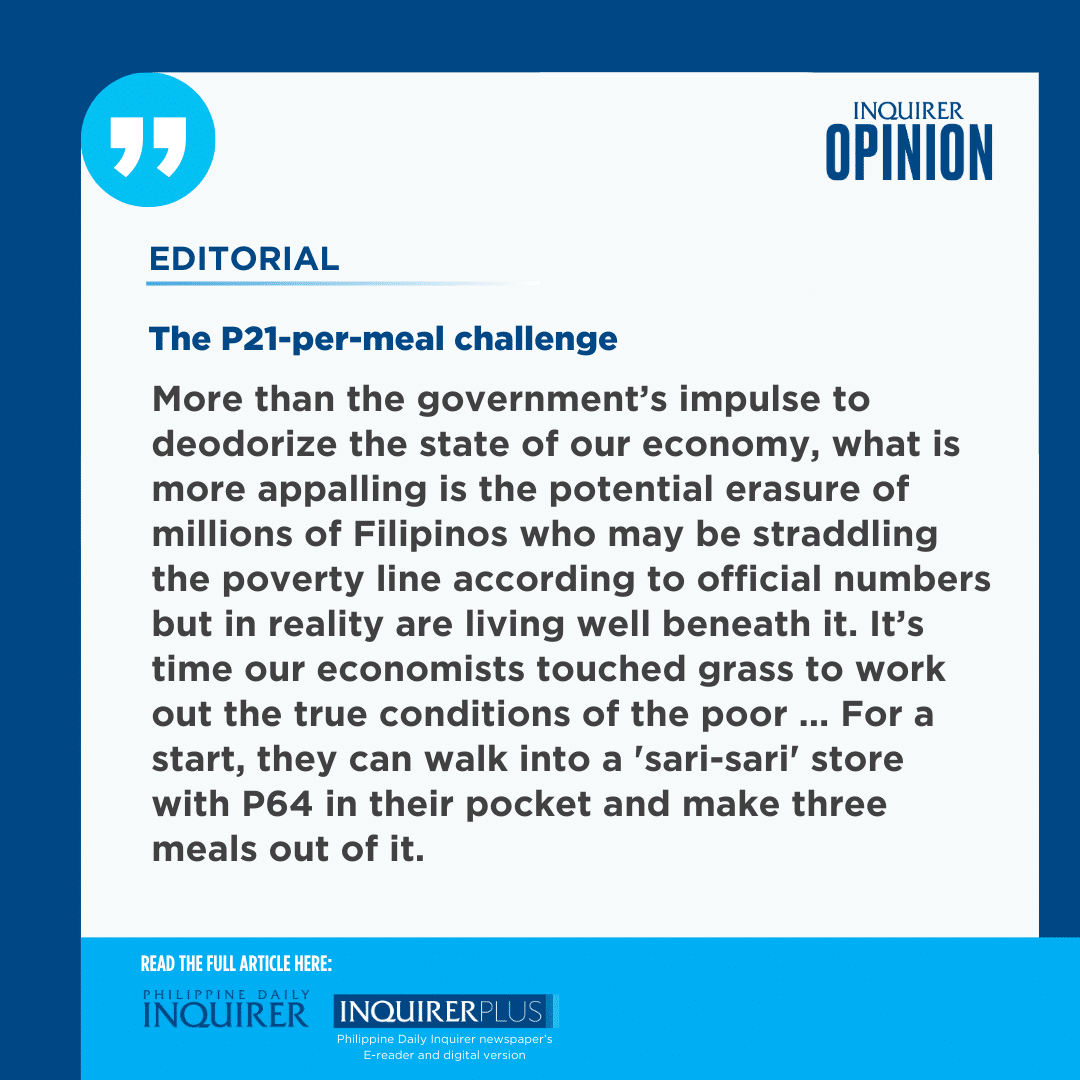When was the last time our economic managers set foot in a wet market or grocery store — 20 years ago? Because, otherwise, it boggles the mind how the government could be so out-of-touch about what food poverty looks like in an ordinary Filipino household.
Speaking at a Senate hearing on Aug. 13, Socioeconomic Planning Secretary Arsenio Balisacan said the monthly threshold for food poverty in 2023 stood at P9,581 for a family of five, or P64 per person per day.
Which means that per the appraisal of the National Economic and Development Authority (Neda), one is not “food poor” if one can scrounge up at least P21 for each meal.
Not surprisingly, the Neda chief’s statement kindled a national uproar, as lawmakers and activists challenged the official to try to survive on that measly budget per meal.
“What planet are these Neda people living on for them to say this?” an outraged House Deputy Minority Leader France Castro of ACT Teachers party list said, adding: “What could P20 buy? Turon or banana cue or noodles?”
Cheapest cost
“That is not even enough for a [cup of] rice and a viand in an eatery,” noted Danilo Ramos of the Kilusang Magbubukid ng Pilipinas.
Asked to explain the numbers last Thursday, the Philippine Statistics Authority (PSA) noted that the food poverty threshold actually rose by 14.7 percent from 2021.
National Statistician Claire Dennis Mapa said the metric was calculated based on a bundle of food items that are locally available in provinces, are low cost and can satisfy the recommended energy and nutrient intake a person needs to live.
At the national level, this menu might consist of a breakfast of scrambled egg, coffee with milk, and a serving of rice; a lunch of a cup of mungbean or “monggo” with malunggay and dried anchovies, a banana, and a serving of rice; and a dinner of fried fish or boiled pork, a vegetable dish, and a serving of rice.
In calculating food expenditure, the PSA chooses the cheapest cost of a specific item, varying across regions and provinces, Mapa explained. For instance, the price of bread is listed at P2 for each slice, and instant noodles at P7 per pack, a Department of Trade and Industry official said at a House hearing.
Review of methodology
But as Balisacan conceded at the Senate inquiry, there might be a need to review the methodology for calculating the threshold amid drastic changes in the economy and accelerating inflation.
Mapa echoed the sentiment: “It’s really insufficient but [the way] we set up the food threshold and the poverty threshold is the minimum basic needs, so it’s the least cost.”
“I agree this is really basic. A lot of people will not be happy about it but that is how the bundle is arrived at. In other words, there is science to it,” he added.
But is the science accurate?
After all, the food poverty threshold is part of the equation used for determining which Filipino households live below the poverty line. Once identified, the families become eligible to receive benefits under the government’s poverty alleviation programs like 4Ps or the Pantawid Pamilyang Pilipino Program.
The nonfood component of the poverty threshold includes clothing and footwear; fuel, light, and water; housing maintenance or rental; medical care; education; transportation and communication; and personal care and effects. Notably, recreation, tobacco, and alcohol are excluded.
“When you compute poverty thresholds using an old number which is obviously not workable anymore, P20 per meal means your poverty forecast is not accurate,” Sen. Grace Poe said on Tuesday.
Sanitized government data
The senator hit the nail on the head: Could the number of indigents be skewed downward as a result of such inaccuracy? It bears noting that last week, the PSA reported that the Philippines’ poverty rate dropped to 15.5 percent last year from 18.1 percent in 2021. Based on the data, some 17.54 million people were living below the poverty line, down by 2.4 million from the 2019 survey.
Now, in the context of how statisticians define food poverty, are these numbers to be trusted? Because if one is not considered poor for being able to spend more than P21 per meal, imagine how many of our people are being counted as nonpoor for such a non-privilege — and being denied the government benefits to which they are entitled?
More than the government’s impulse to deodorize the state of our economy, what is more appalling is the potential erasure of millions of Filipinos who may be straddling the poverty line according to official numbers but in reality are living well beneath it.
As it stands, the food poverty threshold is a good example of the last of the three types of lies made famous by Mark Twain: “lies, d***ed lies, and statistics.”
It’s time our economists touched grass to work out the true conditions of the poor, even if it means putting the lie to sanitized government data. For a start, they can walk into a “sari-sari” store with P64 in their pocket and make three meals out of it.
